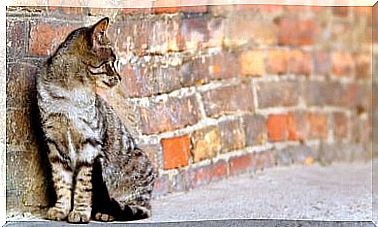Why Do Chimpanzees Use Rocks To Make Sounds?

Humans are not the only animals that use tools to accomplish a task. There are more examples in the world of birds, mammals, some invertebrates and of course primates, our closest relatives. Chimpanzees that are able to use rocks to make sounds among other things.
This type of behavior makes us realize that the world is not as anthropocentric as we often think. There are animals with qualities very similar to humans, which denotes a constant and efficient evolutionary progress. Here we tell you all about the use of tools in chimpanzees.
Chimpanzees use tools
For decades, the habits of different populations of chimpanzees have been studied around the world and it is known that these animals have the ability to use different tools to hunt, make shelters or get food from trees.
These tools are usually objects found in their environment such as leaves, dry branches and rocks. For example, some chimpanzees use long twigs to trap ants and termites from termite mounds or extract honey from a hive. They also use rocks to open hard fruits like walnuts.

Do chimpanzees use rocks to make sounds?
Chimpanzees live in communities of several dozen individuals and inhabit the jungles, forests, and savannas of Africa. Each population is differentiated and usually has a controlled monitoring of its nesting areas, feeding and behavior.
Thanks to these programs , a very particular habit of chimpanzees in West Africa has been discovered. Through the installation of camera traps, a group of chimpanzees have been filmed performing a kind of ritual.
In the recordings you can see how chimpanzees stacked rocks inside the hollow trunk of some trees. Later, after an indeterminate time, they would return individually to pick up some of these stones and throw them against the trees while emitting a loud scream.
This action was repeated in adult individuals, especially males, but also in females and juveniles. The resonance of the impact of rocks against trees has been studied to see if chimpanzees also choose trees to have more sound effect.
It is believed that the primates chose to throw them against a more resonant wood, of trees with open roots, since these tend to produce lower sounds, which are reverberated for a longer time.
Until now, this behavior was totally unknown in chimpanzees and does not seem to be related to the abundance of rocks or the availability of suitable trees, but to some kind of cultural element. The exact motivation for this is not known. Do chimpanzees use rocks to make sounds or is it some kind of ritual?
What has been shown is that there are behavioral differences between the different chimpanzee communities, even within the same one over time, each group or individual can use the same tool in a different way to achieve the same end or vice versa.

Primate culture
Behavioral variations in chimpanzees have been described as “cultural. ” Furthermore, they are transmitted from one individual to another, just as behavior is spread when one person learns from another. Habits in different chimpanzee communities have changed over time, just as they do in human populations.
This behavior of accumulating piles of stones and throwing them has only been detected in some groups. Since it does not seem to have any objective, as with the use of other tools, it is related to cultural elements that remind us of the most primitive rituals of the first hominids.
Knowing in depth the behavior of chimpanzees and other primates is important not only to conserve them as a species, but also to get closer to our closest relatives and understand more about our own human cultural evolution, comparing current primates with the first humans.









